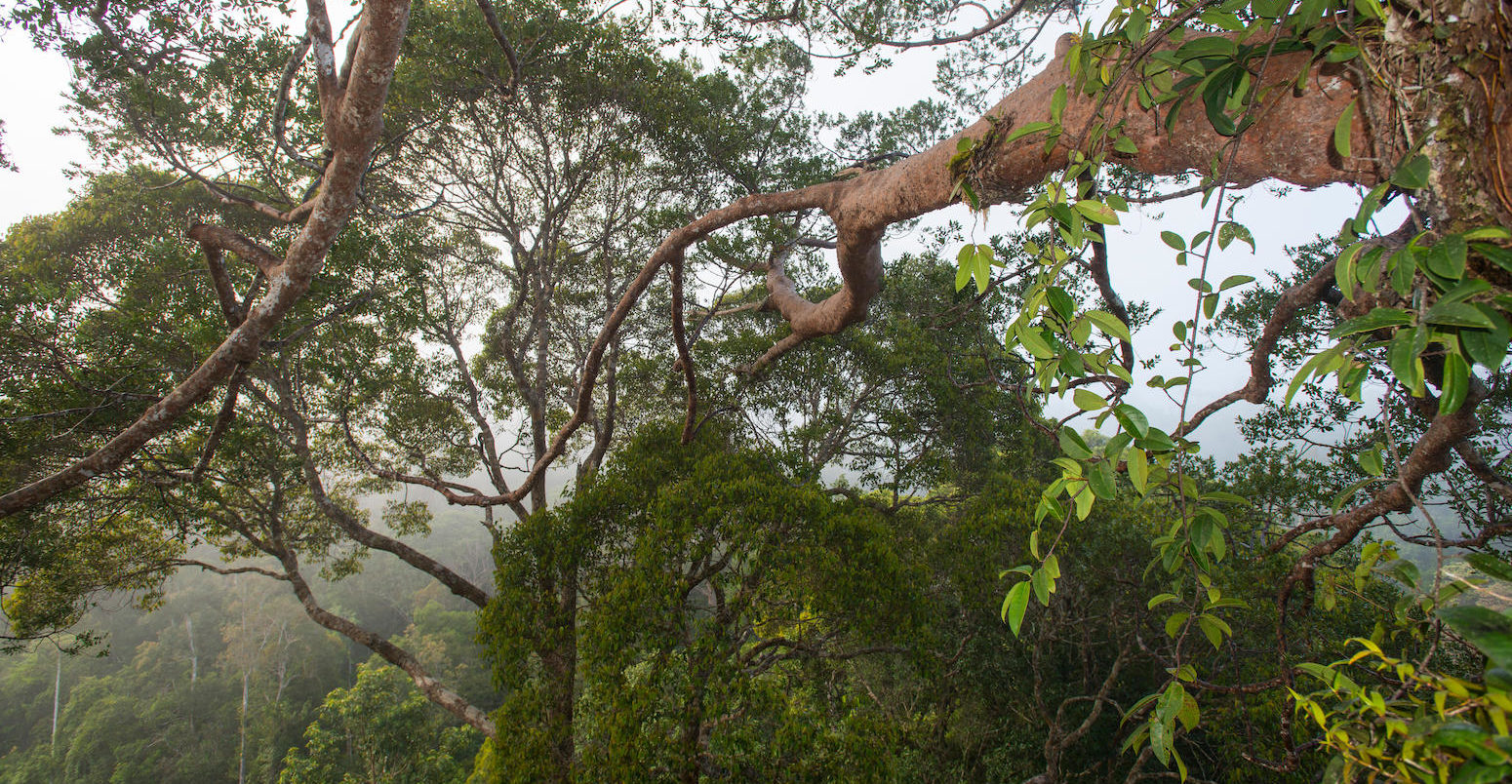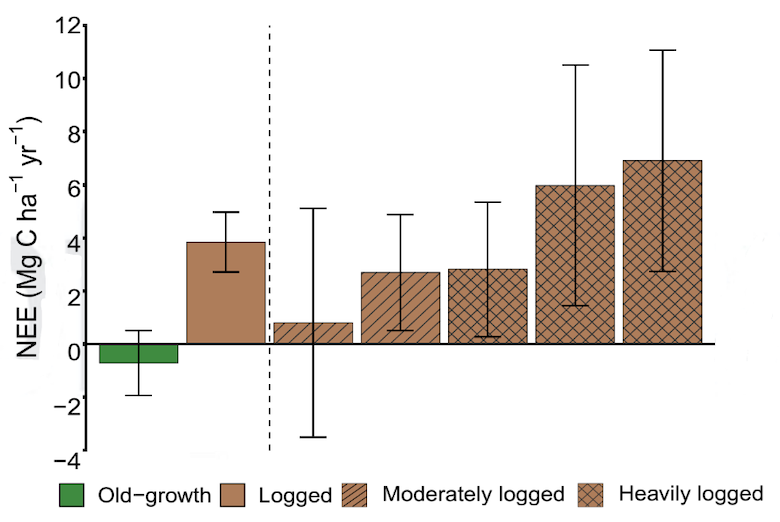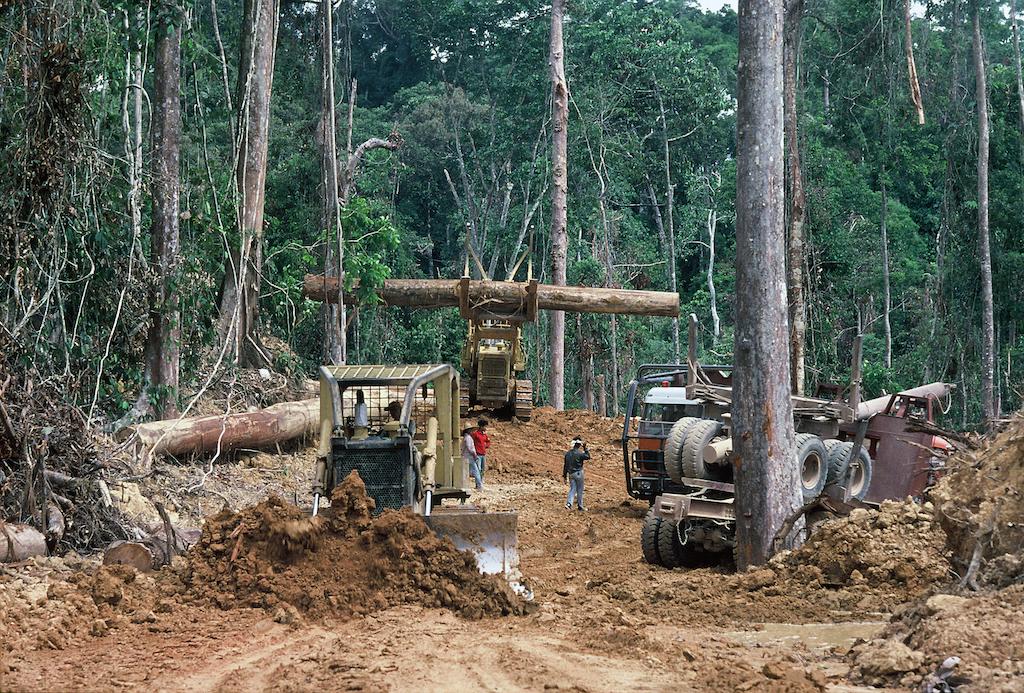
Logged tropical forests are a ‘substantial’ carbon source for at least 10 years
Orla Dwyer
01.09.23Orla Dwyer
09.01.2023 | 8:00pmLogged tropical forests are a net source of carbon emissions for at least one decade after being degraded, according to new research.
Tropical forests that have previously been logged or otherwise degraded are generally thought to take in more carbon than they emit, through quickly re-grown trees.
But new research shows that this carbon uptake is overshadowed “by the high emissions from soil organic matter and from deadwood as a result of logging”, the corresponding author on the paper tells Carbon Brief.
By examining both intact and degraded forest plots, researchers quantify the CO2 emissions and uptake from forests in Malaysian Borneo – an area that has been badly hit by deforestation and forest degradation.
Deforestation refers to the clearing of a forest. A degraded forest, on the other hand, has not been fully cleared but it has been severely impacted by issues such as logging and climate change.
Although the study, published in the Proceedings of the National Academy of Sciences, focuses on just one area, the researchers write that “the potential implications are serious” for the scale of the overall tropical forest carbon sink.
The researchers believe the findings mean that the amount of carbon being sequestered in tropical forests around the world “may be considerably lower than currently estimated”.
Impacts of logging
Around 30% of worldwide greenhouse gas emissions are absorbed by the land – making it an important “carbon sink”.
Forests are crucial components of the global carbon sink. The Amazon, the world’s largest tropical rainforest, stores a huge amount of carbon and houses at least 10% of the world’s biodiversity.
The new study says that tropical forests are “particularly important” for the global carbon budget – the highest level of global net emissions allowable in order to limit global warming to a certain level.
Tropical forests absorbed 15% of all human-generated CO2 emissions between 1990 and 2007, according to a paper published in 2011.
But recent research shows that the carbon-sink capabilities of tropical forests are rapidly declining, even those undisturbed by logging or fires.
A study in 2017 also found that tropical forests are no longer carbon sinks as a result of deforestation and land degradation.
The new study uses two primary methods to quantify CO2 exchange between the ecosystem and the atmosphere in the Malaysian part of Borneo.
Both methods used by the researchers confirm that the landscape is a “substantial net carbon source to the atmosphere for at least a decade after logging”, the study says.
The researchers compared data from moderately and heavily logged forests with those that had not experienced logging.
By measuring plant growth and respiration rates, the researchers found that the logged ecosystem was a source of carbon on 99% of the 455 sampled days sampled.
The chart below shows that heavily logged plots (brown hatched) are a larger CO2 source compared to more moderately logged (brown striped) and unlogged sites (green). While the brown bars show the net emissions from logged sites, the green bar highlights that intact, old growth sites are typically carbon sinks.

The study points out that other research on the recovery of logged and otherwise degraded forests has focused on the trajectory of the ability of forests to store carbon, but generally did not assess the overall carbon budget, including losses from sources such as soil and dead trees.
The researchers write that the plots they examined share characteristics with other tropical forests, but acknowledge that the heavily logged areas “represent more of an extreme and unsustainable approach to logging”, adding that the study “highlights a worst-case scenario”.
“But such high degradation is – unfortunately – not unique to our study site”, the paper continues, referring to similar areas in Indonesia and Myanmar.
“Overall, we believe our study site and our data to be broadly representative of the wider logged tropical forest landscape,” the paper concludes.
A ‘complete picture’
Dr Terhi Riutta, the corresponding author on the new study and a postdoctoral research fellow at the University of Exeter, says most previous studies on this topic examined “individual components” of the ecosystem, such as soil losses or tree growth, but that approach “doesn’t give you the complete picture of what’s happening”. She tells Carbon Brief:
“We know from past studies that the trees grow very fast after logging because there are more gaps, there are more resources available [and] most importantly, light.
“So we expected these forests to be net carbon sinks based on the tree growth, but it turned out to be that the forests are actually net carbon sources. We did find this rapid tree growth, [but] it was offset by the high emissions from soil organic matter and from deadwood as a result of logging.”
Riutta says that logging results in damage beyond just the trees that are “actually extracted” – that “a lot of the neighbouring trees either die at the time of logging, or are damaged at the time of logging and then they die later”.
Borneo – an island politically split between three countries including Malaysia – was chosen as the area of focus partly because it receives less attention than other tropical forests in studies, she says, adding:
“It is a hotspot for emissions from deforestation and forest degradation so it was important to try to quantify those emissions.”

Riutta adds that she and her team do not want the findings to be “used as a justification for converting the logged forests into other land uses” that are harmful, such as oil palm plantations. She tells Carbon Brief:
“We don’t want that because they do harbour an immense biodiversity value compared to plantations and they are rich ecosystems.”
Riutta would also welcome more focus being put on the “health and wellbeing of these logged forests and how we can manage these emissions – rather than just using it as a case that logged forests are somehow bad”, she says.
Further study around the world
Academics not involved in this research say the findings back up studies conducted in other parts of the world.
Dr Celso H. L. Silva-Junior, a Brazilian postdoctoral researcher at the University of California, Los Angeles, says the research “reaffirms a concern that Amazonian scientists have raised in the region: the contribution of emissions from forest degradation (e.g., logging, fire, edge effect) to the carbon budget of the region”.
Silva-Junior says that the research “brings an important advance by considering the total carbon budget of logged forests and demonstrating that these areas act as a carbon source for the atmosphere”. He tells Carbon Brief in an email:
“Although previous studies in the tropics have shown a fast recovery of carbon stocks due to rapid tree regrowth, in the Amazon, for example, depending on the intensity of selective logging, forests take decades to recover the original carbon stocks.”
Dr Jamilah Mohd Salim, an associate professor at the Universiti Malaysia Terengganu, says the Malaysian Borneo economy is “still largely depend[ent] on the revenue” from the forest and palm oil plantations. She tells Carbon Brief in an email:
“Such research findings need to be communicated from the scientific community to the local government and larger public to correct the misleading fact on the effect of logging or forest tree removal.”
“Something greater than logging revenue (e.g., carbon financing) should be offered by the market to the state with the forested land so that [there is] more incentive to maintain their forest for carbon and climate.”
Salim says that the research results will not be surprising to people in her field of study, but among non-experts she thinks there is still a belief that logged tropical forests continue to take in more carbon than they put out. She adds:
“The newly sequestered carbon will not be equitable to the original carbon sink and could not compensate for carbon losses due to logging. On the other hand, logging could increase heterotrophic activities such as decomposition and soil degradation, which could worsen the carbon balance in a forest ecosystem.”
Silva-Junior says that this kind of research helps to improve estimates of carbon emissions from degradation and can aid in planning to mitigate and prevent emissions from these forests. He adds:
“We still need to go beyond the humid tropical forests; little is known about the effect of the different drivers of degradation in tropical dry forests, for example. In addition, researchers also need to focus on other gaps, such as understanding the impact of forest degradation on biodiversity.”
Mills, M. B. et al. (2023) Tropical forests post-logging are a persistent net carbon source to the atmosphere, Proceedings of the National Academy of Sciences, doi:10.1073/pnas.2214462120
-
Logged tropical forests are a ‘substantial’ carbon source for at least 10 years





